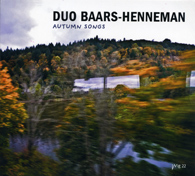Duo Baars - Henneman
Autumn Songs
(Wig)
Year
after year, I see that a growing percentage of the music that I consider
as deserving my time and my undivided attention comes from Holland. A fact
that, it goes without saying, has nothing to do with such things as
"ethnicity", but a lot to do with such things as "cultural
models of organization" which prove themselves to be favourable to the
prospering of good ideas (and please, let's also take the dimension called
"Protestant Ethic" into account).
Ab Baars and Ig Henneman have long been important figures in this landscape,
and in the course of the last decade I've often written about their work
in my reviews. I'm sure readers will recall - here I'm only talking about
works on which they both appear - albums such as Sliptong (2009), a trio
featuring Misha Mengelberg on piano; and the fine work titled Cut A Caper (2011), released under the name Ig Henneman
Sextet.
But
I think there is a quality that is quite specific to the duo music of Baars
and Henneman, as it was amply demonstrated by their album Stof
(2007). I'm obviously taking for granted their long journey together
and their completing each other when skillfully combining composition and
improvisation, while at the same time highlighting the complex multi-style
approach which for a long time now is their everyday occupation.
The
liner notes to Autumn Songs alert us to the fact that "This suite
of freely improvised and minimally composed pieces is developed by Baars
and Henneman for a USA tour in the autumn of 2012". The music was
recorded on November 30, 2012 at the famous Bimhuis, Amsterdam. The very
good recorded sound is by Micha de Kanter, who mixed and edited the music
together with Baars and Henneman.
The
inspiration to the tracks is what once I would define as "highbrow":
literature, poetry, music, painting, and so on, with names such as William
Blake, W.B.Yeats, Charles Ives, Guillaume Apollinaire and Rainer Maria
Rilke. There's also autumn as experienced first-hand, in the piece Autumn
In Maine, which was obviously "inspired by the autumnal colors in
Maine". Here I hope the musicians won't be upset if I say that though
I'm definitely not familiar with most of their sources of inspiration for
this music, still I greatly enjoyed listening to it.
As
per his custom in such contexts, Ab Baars is on tenor sax, clarinet, and
shakuhachi. Ig Henneman is on viola. The music on this album (which has
a perfect duration, by the way: 51' for 10 tracks) successfully inhabits
a
"dry", anti-rhetorical dimension, whose beauty has to be discovered
and investigated, but which once in a while suddenly shows itself in the
open.
Let's
have a quick look at the pieces.
Brows
Of Morning opens unison, a calm melody which could be described as resembling
chamber music, a melody for Alps Horn, or a theme by Eric Dolphy off Out
To Lunch. Ab Baars is on tenor, the viola at its side. There's a fine moment
- definitely quite Ayler/Mitchell-like - in the sax solo, then a fine viola
solo. There's a theme appearing here and there, and a "hushed" close.
Nine
And Fifty Swans, for viola e clarinet, is inspired by The Wild Swans At
Coole by Yeats (I wonder whether I would consider the piece as featuring
wings and honks, had I been unaware of its "birdy" origin). The
piece definitely lives in a "Pastoral" dimension. There are contrasting
registers here, with a high viola, and a low clarinet. There's a fine unison
starting at about 3'10". Then, a "peaceful" ending (which
sounds
"cut").
Winter
Comes To Hush Her Song features the slow, solemn blowing of the shakuhachi
paired with the viola hit with arco, sounding almost like a koto. An
"eastern" atmosphere reigns.
It
Bends It Sways is for viola and tenor. The viola at times sounds shrill,
agitated, then calm. The tenor has "shouting" moments, rich with
overtones. There's definitely a theme, at the start, also the end, of the
piece.
Poor
Autumn has a fine little theme of a "dancing/chamber-like" nature,
which to me sounds as being typical of Henneman, the clarinet getting a
solo part in the theme. Though there's a "dramatic" transition
at about 3', this piece sounds a lot less sad and tragic than I expected,
given its title and inspiration. The fine theme comes back at the end.
The
Clouds Go: Well, maybe I'm hallucinating, but the blowing from the shakuachi
and the slow "movement" of the "held" notes on the
viola reminded me of a "gaseous" entity. It's a fine piece anyway,
with a microtonal aspect.
Restlessly,
for viola and tenor, inhabits a pointillistic dimension, which at times
reminded me of Roscoe Mitchell's explorations for alto. There's a
"lyric"-sounding theme a the end.
Autumn
In Maine, for viola and clarinet, is maybe the most accessible episode
here. There's a lively-sounding intermezzo for the clarinet's higher register,
with an ending that sounds peaceful, and, in its own way, quite majestic.
The
Heavy Cargo. Viola pizzicato, "hushed" clarinet. Then it's viola
con arco, a mixture of jazz and chamber-like. The viola is the main character
here, the clarinet quite still, playing an "ostinato" arpeggio.
There's a theme that flows from the viola solo, then a sad-sounding theme.
Then the instruments change their roles, the viola acting as a "pedal" while
the clarinet performs the theme. This is a very beautiful moment.
Rain
Curtains features the shakuachi in a mix of
"Easten"/"Scottish". The shakuachi blows, then it goes
to a higher register for the melody, and theme. A viola solo, with a
"still-sounding" shakuachi acting as counterpoint. There's a beautiful
theme at the end, the perfect close to the piece, and the whole concert/work.
Beppe
Colli
© Beppe Colli 2013
CloudsandClocks.net | May
5, 2013











